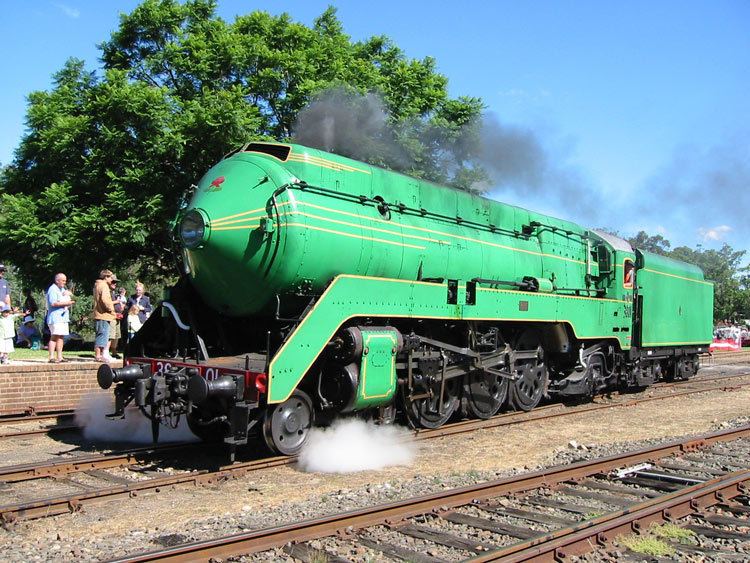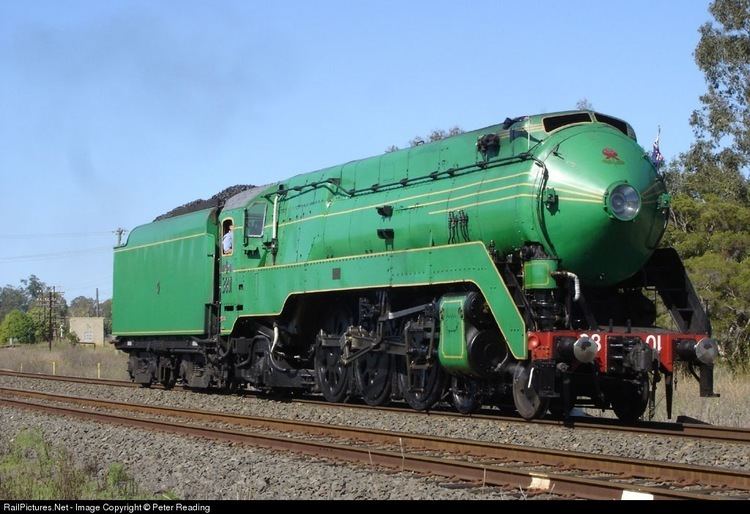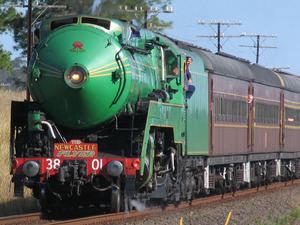Power type Steam Build date 1943 UIC class 2′C1′ h | ||
 | ||
Gauge 4 ft 8 ⁄2 in (1,435 mm) | ||
3801 steam locomotive at maitland nsw australia
3801 (pronounced Thirty-eight o-one) is a 4-6-2 steam locomotive operated by the New South Wales Government Railways between 1943 and 1976. It is arguably Australia's most famous steam locomotive, being the only one to have visited all main line states and territories.
Contents
- 3801 steam locomotive at maitland nsw australia
- 3801 3830 steam train melbourne ararat portland april 2000
- Construction
- In service
- Preservation
- 2008 2017 overhaul
- 3801 Limited
- Trainworks Railway Museum
- Transport Heritage NSW
- Major accomplishments and events
- References

3801 3830 steam train melbourne ararat portland april 2000
Construction

3801 was built in 1943 by Clyde Engineering as the first of 30 38 class locomotives built to haul express trains. The first five were built by Clyde Engineering to a streamlined design, whilst the later 25 locomotives in the class were built by Eveleigh and Cardiff Locomotive Workshops and were unstreamlined.

The 38 class were first conceived in 1938. They suffered many delays during construction due to material shortages caused by World War II. 3801 was the first engine completed late 1942 and entered service on 22 January 1943 to little fanfare. It became known at the time as the Grey Nurse due to its drab, all grey colour scheme, a wartime economy.
In service

On 25 February 1943, 3801 worked the Newcastle Flyer for the first time. When joined by 3802 in April 1943, these engines were allotted to working the Melbourne Limited expresses between Sydney and Goulburn. In early 1947 3801 was given a heavy overhaul and was painted in its standard colour scheme of green with yellow lining. A Waratah emblem was added to the top of the nose cone in later years. In 1955 3801 was overhauled again, being painted black with red lining as a cost-cutting measure. It was around this time that diesel locomotives started appearing on the rails of NSW. These would take the "glamour workings" away from the 38 class, who would be confined to all-stations passenger and even goods trains. In December 1956 3801 was the first in its class to accrue 1 million miles (1.61 million kilometres).

In early 1963 3801 was given a major overhaul during which it was repainted green. It was often used on special services operated by railway heritage organisations, the most famous being a non-stop run from Sydney to Newcastle on 28 June 1964. Just failing to break the two-hour barrier, this remained the fastest journey from Sydney to Newcastle by rail (2 hours 1 minute 51 seconds) until bettered by an XPT in 1988. On the return journey 3801 again fell just short of the two-hour mark. In October 1965 the locomotive was found to have serious boiler problems, so was withdrawn and placed in the care of the New South Wales Rail Transport Museum. The museum contributed $18,000 to return 3801 to service and the boiler from 3819 was fitted. In October 1966 3801 returned to service, however the following year boiler problems re-emerged and the loco was withdrawn. Another boiler exam gave the loco a reprieve and allowed it to return to service. During this time it operated a train celebrating the 25th anniversary of the Newcastle Flyer on 31 May 1969, as well as the Western Endeavour special across the continent to Perth between 22 August and 12 September 1970. In October 1972, 3801 worked to South Australia with 3642 as part of celebrations to open the Whyalla line.
From April 1974 the Public Transport Commission all steam trains were barred from New South Wales main lines, however during June and July of that year 3801 was allowed back to be used as the star of the award-winning film A Steam Train Passes.
Preservation
3801 returned to service on 6 January 1975, operating services on the Bankstown line to help raise money for survivors of Cyclone Tracy. After this 3801 was deeded to the Rail Transport Museum. In June 1975, it hauled 5711 and 1905 to Thirlmere when the New South Wales Rail Transport Museum relocated. The engine was then used on tours until December 1976, when boiler problems led to its withdrawal.
In November 1982 David Hill Chief Executive of the State Rail Authority enquired about the suitability of restoring 3801. Hill had the 1988 Bicentenary of British settlement in Australia in mind, and saw a restored 3801 as a representative of Australia's railways. The boiler was the major item needing repair and an investigation needed to be carried out to ascertain if restoration was viable. A visit was made to the South Maitland Railways (who at the time still used steam engines) to learn about modern boiler techniques. It was discovered that many advances had been made and it was possible to return boilers to service which previously would have been scrapped. The next step was to examine the boilers of the other preserved 38 class members - 3820 and 3830 (though 3813 had survived, it was completely stripped and in two different locations) - and compare them with 3801's boiler. It was decided to use the boiler already in 3801, however the inner firebox had suffered thermal fractures and would need extensive repairs. Restoration was deemed possible and a fund-raising appeal began.
With some finance raised, 3801 was taken to the State Dockyard in Newcastle on 20 November 1983 for restoration by the Hunter Valley Training Company - an apprenticeship scheme later involved in the restoration of 3830. This was due to the railway's workshops being stretched by regular work. It was marshalled behind 8111 on an excursion train from Sydney.
The firebox was to be completely replaced, however the dies and jigs used to press the boiler metal had been scrapped, so the old firebox was used as a template. The new firebox had a different shape and this reduced the boiler pressure from 245 psi to 215 psi. It was decided to weld the new firebox and some conservative engineers were sceptical as to whether this would work. Repairs and reconditioning of many other components were also carried out. The tender tank was so rusted, it needed to be replaced. The new tank was welded rather than riveted and this resulted in a sleek, plain tender. On 8 November 1986 a fire was lit for the first time. By 10 November 3801 was running around nearby sidings. More short trials followed and on 15 November 3801 was handed over and hauled a train to Maitland. More trial runs followed and on 19 November 1986, 3801 headed from Newcastle to a grand ball on the concourse of Sydney's Central station.
After restoration 3801 operated heritage trains throughout New South Wales. It was operated by 3801 Limited under a 20-year lease. During the Australian Bicentenary celebrations in 1988, it operated an extensive program across Australia visiting every mainland capital accessible by rail including another trip to Perth in April/May 1988. In October 1988, Flying Scotsman arrived from England and for much of its year long tour across Australia was accompanied by 3801.
On 6 May 1990, 3801 was involved in the Cowan rail disaster. 3801 was struggling to climb the Cowan Bank (on the Sydney side of the Hawkesbury River) when returning from the Morpeth Jazz Festival when a CityRail Interurban passenger service crashed into the back of 3801's train. Six people lost their lives, including driver of the intercity electric, and a passenger in the V Set's cab. 3801 applied sand to the track to assist grip and an investigation into the crash suggested this may have caused the signals to malfunction. The signals changed from red to green several times. After the signals were green for a few moments, the interurban driver then entered the tunnel behind 3801 where the accident occurred. The handbrake in one of the carriages may also have been applied.
In 1992 3801 visited Alice Springs for the first time, using the standard gauge track laid in 1980. The locomotive was awarded an Historic Engineering Marker plaque by Engineers Australia on 6 November 1994, the ceremony taking place at Robertson. 3801 was a regular at the Hunter Valley Steamfest.
Despite a campaign by 3801 Limited to retain custodianship of the locomotive, on 26 November 2006 the custodianship passed back to the New South Wales Rail Transport Museum. The locomotive continued to haul day trips and longer excursions until withdrawn from service for a major overhaul at the end of 2007.
2008-2017 overhaul
When 3801 was withdrawn in 2007, it was decided to replace the original boiler with a new welded one as well as conducting various mechanical repairs. This was timetabled to be complete by the end of 2010. The contract for the construction of the new boiler was let to Dampflokwerk Meiningen in Germany, while the tender tank was transferred to the Hunter Valley Training Company at Maitland for repair.
The 3801 website features updates on the locomotives progress issued by the NSW Office of Rail Heritage, with archived updates available separately.
In May 2013, Transport Minister Gladys Berejiklian acknowledged the importance of 3801 saying it would be a priority of the new not-for-profit company Transport Heritage NSW to return 3801 to service.
In November 2014 a spokesman for Transport for NSW announced that the boiler for the 3801 steam locomotive would be brought to Australia so that local experts can get the locomotive back on the tracks. In September 2015, Transport Heritage NSW announced that 3801 would return to service in 2017.
3801 Limited
It was decided during restoration that a separate organisation needed to be formed to manage 3801 when it returned to service. In 1984, 3801 Limited was established to oversee the operation of the locomotive. The State Rail Authority, the New South Wales Rail Transport Museum and the Australian Railway Historical Society were former stakeholders. In 2005 RailCorp advised that 3801 Limited's fixed term 20-year lease would not be renewed.
Trainworks Railway Museum
The locomotive's original and now current custodian, the Trainworks Railway Museum, is an independent, not for profit company, established in 1962. The museum is located in Thirlmere, south-west of Sydney. The Museum was a foundation and managing member of 3801 Limited and indicated the locomotive would continue to provide mainline tours but at a reduced frequency when it returns to service.
Transport Heritage NSW
A new not-for-profit company called Transport Heritage NSW was set up to manage rail heritage in NSW in 2013. In May 2013, Transport Minister Gladys Berejiklian stated "The NSW Government is committed to locomotive 3801 operating again in NSW." In December 2013 Berejiklian said an important stage in the creation of Transport Heritage NSW was reached, with a clear majority of the NSW Rail Transport Museum members voting in support of the new era for rail heritage.
